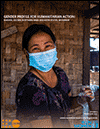What's New
Displaying results 431 - 440 of 4913

Resource | Publications,
The Strategic Plan 2022–2025 will guide UN Women for the next four years—with an eye toward the 2030 deadline to achieve the Sustainable Development Goals. It articulates how UN Women will leverage its unique triple mandate to mobilize urgent and sustained action to achieve gender equality and the empowerment of all women and girls and support the achievement of the 2030 Agenda for Sustainable Development.

Resource | Publications,
The 2021 version of the Gender in Humanitarian Action (GiHA) profile includes an analysis of the gender-related impacts of the COVID-19 pandemic and the February military coup in Rakhine, Kachin, Northern Shan and Kayin States in Myanmar. In 2020 and 2021, the COVID-19 pandemic further complicated the lives of people in humanitarian settings across the country, resulting in significant economic and health impacts.

Resource | Publications,
This updated Comprehensive Mental Health Action Plan 2013-2030 builds upon its predecessor and sets out clear actions for Member States, the WHO Secretariat and international, regional and national partners to promote mental health and well-being for all, to prevent mental health conditions for those at-risk and to achieve universal coverage for mental health services. While the updated action plan includes new and updated indicators and implementation options, the original four major objectives remain unchanged: more effective leadership and governance for mental health; the provision of comprehensive, integrated mental health and social care services in community-based settings; implementation of strategies for promotion and prevention; and strengthened information systems, evidence and research.

Resource | Publications,
The WHO Global Health Sector Strategy (GHSS) on Sexually Transmitted Infections (STI), 2016–2021 (resolution WHA69.22 [2016]) includes country milestones for achievement by 2020 and global targets for achievement by 2030. In addition, countries were called to identify national STI targets for 2020 and beyond.
From October 2019 through April 2020, a country survey was distributed to WHO Member States through WHO regional offices to measure progress towards the achievement of the following 2020 STI-specific milestones within the global STI strategy.

Resource | Publications,
WHO’s antiretroviral treatment (ART) clinic-based acquired drug resistance survey method yields robust estimates of HIV viral suppression and acquired HIV drug resistance in adults, children and adolescents taking both dolutegravir and non-dolutegravir based regimens.
Results are used to inform ART programme decision making regarding optimal ART regimens and support evaluation of programme quality with respect to maximizing viral load suppression and minimizing emergence of resistance in people taking ART.
Resource | Publications,
NCASC published second edition of user manual for HIV Care and ART Tracking (DHIS2 Tracker, mHealth and Biometric) System. This updated manual covers the series of changes made within the system after user feedback, developers changes, updates of the National Guidelines so that this will help all the technical staff (Clinicians, HIV Focal Person, Medical Recorder, HIV/ART Counselor and Data Capturer) of the HTC and ART centers of various non-government and government organizations to keep records and make reports of HIV-related services based on recommended format of iHMIS.

Resource | Publications,
During initial days of COVID pandemic, HIV infection was not considered as a risk factor for COVID-19 or more severe disease. However, recent studies conducted in larger samples suggest that PLHIV (particularly with low CD4 counts or not under ART) if infected with COVID are more likely to have severe clinical course in comparison to HIV negatives (Ambrosioni et al 2021).
Moreover, the COVID-19 pandemic has hugely disrupted HIV prevention and treatment services globally and created challenges to continue the essential service delivery. A recent modelling study suggests that in sub-Saharan Africa a 6-month interruption of ART would result in an excess of 500 000 adult deaths from HIV infection during a 4-year period and an up to twofold increase in mother-to-child transmission of HIV.

Resource | Publications,
The Results Report reveals the catastrophic impact the COVID-19 pandemic had on the fight against TB worldwide. In 2020, the number of people treated for drug-resistant TB in the countries where the Global Fund invests dropped by a staggering 19%, with those on treatment for extensively drug-resistant TB registering an even bigger drop of 37%. The number of HIV-positive TB patients on antiretroviral treatment as well as TB treatment dropped by 16%.
The report also highlights significant declines in HIV testing and prevention services for key and vulnerable populations who were already disproportionately affected. Compared with 2019, people reached with HIV prevention programs and services declined by 11% while young people reached with prevention services declined by 12%. Mothers receiving medicine to prevent transmitting HIV to their babies dropped by 4.5%. HIV testing dropped by 22%, holding back HIV treatment initiation in most countries.

Resource | Publications,
Member states recognized the need for all countries to have unhindered, timely access to quality, safe, efficacious and affordable diagnostics, therapeutics, medicines and vaccines, and essential health technologies despite challenges faced during COVID-19. Progress has been made in the areas of medicine pricing policies, transparency in decision-making processes, building resilient supply chains, and strengthening of National Medicines Regulatory Authorities (NMRA)s through South-East Asia Regulatory Network (SEARN).

Resource | Publications,
The sixth annual report on Monitoring progress towards UHC and the health-related SDGs in the South-East Asia Region provides a comprehensive overview on where we are and what is needed to achieve the UHC and health-related SDGs. The report highlights progress in the areas of reproductive, maternal, neonatal and child health, communicable diseases, non-communicable diseases and health systems. This year’s report includes forecasts for progress likely to be achieved towards those health-related SDG indicators where we can model projections to 2030. A section of this report examines health equity and who is being left behind in the Region. The final part of the report provides Member States’ SDG profile, reporting on health and health-related SDGs. The information and analysis in the report can be utilized to sustain and accelerate progress towards Regional Flagship Priorities and the SDG targets.





